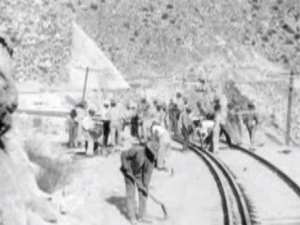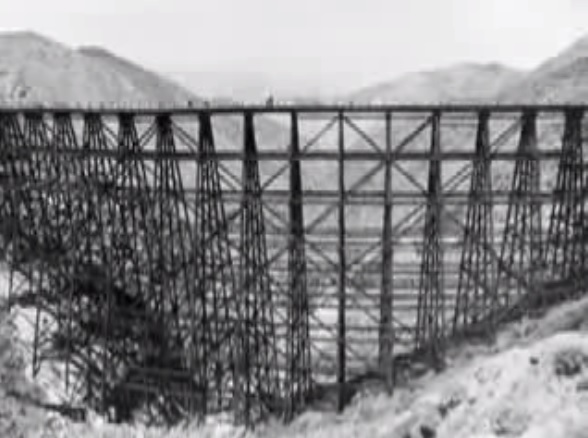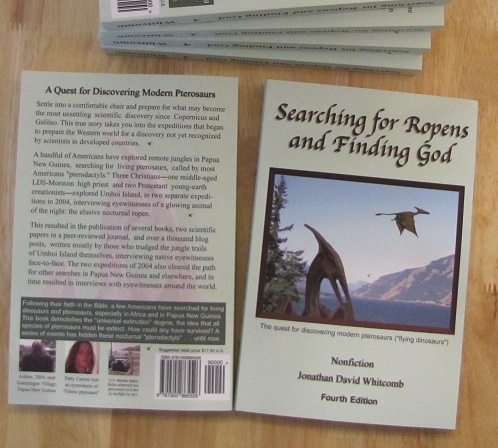Ghost Lights of Anza Borrego State Park—that video appears to be no longer available online except for the first few minutes of the documentary, which introduction enlightens us on how the mysterious flying lights terrified railway workers in the nineteenth century, in a desert in Southern California. The video calls the flying lights “a large number of unexplained floating orbs of light.” I believe those luminous nocturnal entities may be a species of ropen, a bioluminescent long-tailed pterosaur.
Called “ghost lights,” they’ve been explained as everything from “ball lightning” to “spirits of Native Americans long since dead.” The ghost lights first came to the public attention in the “early” 1900’s, when John D. Spreckels [born in 1853] began construction on the impossible San Diego and Arizona Railways, through the treacherous Carrizo Gorge. Working conditions were both uncomfortable and terrifying . . . and on moonless nights the camps were plagued by mysterious hovering balls of colored light. At least one worker was driven mad by fear.

Railroad workers, 19th century, possibly in Southern California
To interject, I am impressed with the documentary, notwithstanding it’s less than nine minutes long. Regarding that one man who was thought to have been driven mad, I’m not so sure. From my eleven years of investigating eyewitness accounts of apparent living pterosaurs, I have seen the insanity accusation thrown at anybody who reports such flying creatures. Did the man report seeing a dragon? That would do it. I’m aware that a limited number of barn owls have been reported, at least under some conditions, to glow. I learned about that apparent bioluminescence from the Australian researcher and nonfiction author Fred Silcock. But I doubt that any barn owls would congregate enough, while glowing, to give railway workers an impression of “a large number” of lights; perhaps the video exaggerates the quantity. But the many sighting reports of apparent pterosaurs flying in Southern California—that suggests those flying lights of the Anza Borrego desert may be creatures related to the ropen of Papua New Guinea or the bioluminescent flying predators called Marfa Lights in Texas.
 People thought it impossible, until railroad workers finished that line to San Diego
People thought it impossible, until railroad workers finished that line to San Diego
Half way through the Ghost Lights of Anza Borrego State Park documentary, the mud caves of the Badlands are exposed. Some of the caves, according to the video, are “more than a mile” long. Yet even if that length is exaggerated, many openings, including ceiling holes, would make the caves ideal for a family of nocturnal flying predators or scavengers, an ideal bedroom to hide in the daylight. ### . Arroyo Tapiado Carrizo Badlands Mud Caves
One of the most fascinating points of interest in the Anza-Borrego Desert State Park is the system of caves known as the Arroyo Tapiado Mud Caves. . . . The mud caves are found along the walls of this wash canyon. One of the most extensive mud cave systems in the world, they contain approximately 22 known caves and 9 slot canyons.
I communicated with Mr. Bunnell early in 2010, by emails, telling him about my ideas about nocturnal bioluminescent flying predators that intelligently hunt bats in southwest Texas.
David Woetzel saw the ropen-light briefly in 2004 [in Papua New Guinea]. He saw no shape to the glowing object, but it was heading towards the Lake Pung area [on Umboi Island], where several eyewitnesses had previously seen a giant featherless flying creature.
.  Quoting from this nonfiction live-pterosaur book:
Quoting from this nonfiction live-pterosaur book:
Grave robbery in both Africa and Papua New Guinea—it looked like too much for a coincidence. Both ropens and kongamatos appeared to be real creatures. The authenticity of an old photograph in a library book became irrelevant. Those flying creatures, more than legends, might be pterosaurs. [from page 17] In one of the interviews, Eunice, a school teacher’s wife, described to Carl Baugh an attempted grave robbery. One night, in April of 1993, near the northwest coast of Umboi Island, after a large funeral procession arrived at the burial location, from the sea approached a flying creature with a tail that glowed red like burning embers glow. About two hundred mourners were awake when it flew overhead. The islanders banged pots and yelled, whereupon the intruder flew into a nearby swamp and the light disappeared. [from page 19] Let’s be clear: No flying fox can terrify a group of islanders by flying over a lake. Furthermore, fruit bats never grow long tails, never eat fish, never glow at night, and never dig up the grave of a recently-deceased human to carry away the body. What do fruit bats eat? Fruit. Think of a miracle of science fiction: If a fruit bat grew to become longer than a village hut, it might devour the garden—but not the gardener. Now think of reality: A fruit bat never impersonates a giant long-tailed Rhamphorhynchoid pterosaur. [from page 24] Other villagers saw the ropen light fly to or from Mount Bel. John Anton, of Gomlongon, on September 19, 2004, at 8:00 p.m., saw what he described as rainbow colors flying from Mount Talnok (near Bel) toward the south beach. Dianne Aisi, of Opai, in 2001, between 8:00 p.m. and 10:00 p.m., saw the light flying from the Tarawe Village area toward Mount Bel. Jefron Ambalis, of Opai, saw it four years earlier, at about 9:00 p.m., flying from Bel toward Lake Pung. A few days after these interviews, three eyewitnesses would describe to me a ropen that had flown, in clear daylight, over that crater lake. [from page 60]
.



2 Replies to “Ropen Lights in Southern California?”
Comments are closed.